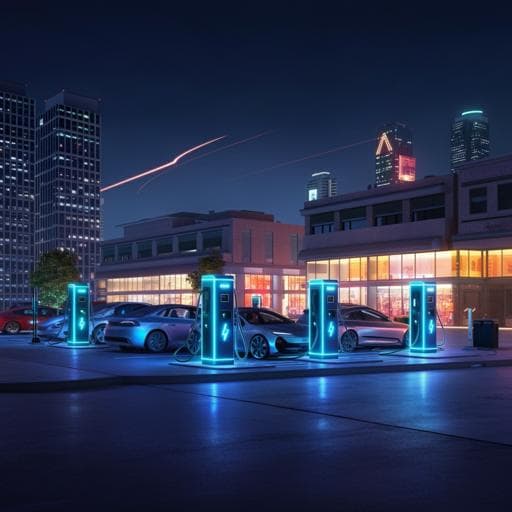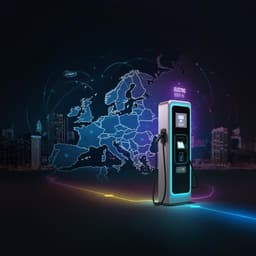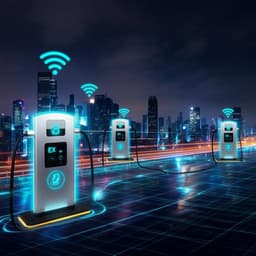
Economics
Effects of electric vehicle charging stations on the economic vitality of local businesses
Y. Zheng, D. R. Keith, et al.
Discover how electric vehicle charging stations (EVCS) significantly influence nearby businesses in California, boosting annual spending, especially for those within 100 meters. This compelling research, conducted by Yunhan Zheng, David R. Keith, Shenhao Wang, Mi Diao, and Jinhua Zhao, reveals the economic benefits of public EVCS, particularly for underprivileged areas!
~3 min • Beginner • English
Introduction
The study investigates whether and how public electric vehicle charging stations (EVCS) affect the economic vitality of nearby businesses. As EV adoption accelerates and public charging networks expand—supported by major policies such as the U.S. Infrastructure Investment and Jobs Act—EVCS may influence local commerce by drawing drivers who spend time at nearby points of interest (POIs) during charging and by making sites with charging more attractive to shoppers. Despite extensive research on environmental benefits of EVs/EVCS, there is a gap in causal, large-scale evidence on EVCS impacts on customer visits and spending at local businesses. The purpose is to quantify causal effects of EVCS installations on customer counts and spending at proximate POIs in California, to inform policymakers, EVCS providers, and business owners about the broader economic implications and equity dimensions of EVCS deployment.
Literature Review
Prior industry reports and pilots suggest EVCS can increase customer visits and spending, but they often lack scale and causal identification. Related transportation infrastructure studies (e.g., new rail/subway stations, bus stops, street designs improving accessibility) generally find positive effects on retail sales, yet the specific role of EVCS has been largely unexamined. Research also notes spatial determinants of EVCS siting and disparities in charger access by income and race, as well as externalities of EVCS on adoption, air pollution, and housing prices. This study addresses the empirical gap with a large-scale, causal design focusing on EVCS-business interactions, including heterogeneity by charger type, POI type, geography (including underprivileged areas), and customer income groups.
Methodology
Setting and periods: California, focusing on two study windows to avoid pandemic and data anomalies: calendar year 2019 and January 2021–June 2023 (EVCS openings from February 2021 onward; January 2021 used as baseline). Data: EVCS data from DOE AFDC (locations, open dates, port counts by Level 2 and DC fast, public accessibility); POI universe and attributes from SafeGraph Places (categories, openings/closings); monthly customer counts and total spending from SafeGraph Spending (anonymized card transactions, excluding cash); customer income distribution from SafeGraph Spending (proprietary classification); median distance from home and dwell time from Advan Pattern; socio-demographics from ACS; underprivileged community designations from California Energy Commission (California + Justice40 criteria); EV sales from CEC; built environment and walkability from EPA Smart Location Database; building footprints from OpenStreetMap. Identification strategy: To mitigate non-random EVCS siting and endogeneity, the study combines (1) propensity score matching (PSM) with exact matching on POI category and nearest-neighbor matching on built environment, socio-demographics, EV sales per 1000, and pre-treatment POI activity (customers, spending); (2) difference-in-differences (DID) with individual POI fixed effects and county-by-month fixed effects; and (3) event studies testing for pre-trends. Treatment definition: Treated POIs are those within 500 m of an EVCS that opened during the study period; controls are POIs without a newly opened EVCS within 500 m in the same period. Underprivileged analyses restrict both treated and control POIs to underprivileged tracts. Outcomes: log(customer count) and log(total spending) per POI-month. Core DID model estimates marginal effect per added charging port; distance-varying model uses five 100 m bins from 0–100 to 400–500 m; event study examines dynamics around installation; heterogeneity models separate Level 2 vs DC fast effects and stratify by POI categories (restaurants, grocery/clothing, hotels, gas stations with convenience stores); income-group-specific models estimate effects for seven income brackets. Monetary translation: Converts percentage effects to changes in annual customers and dollars at a single POI using average pre-treatment levels and average ports per station (a), then aggregates across POIs within 500 m (using average number of nearby POIs per EVCS) and across all EVCS installed. Standard errors are clustered at POI level; matching balance and model diagnostics provided in Supplementary materials.
Key Findings
- Average effects per added charging port at nearby POIs: In 2019, +0.21% customer count and +0.25% spending; in 2021–2023, +0.14% customer count and +0.16% spending (all statistically significant). Effects persist in underprivileged areas: 2019, +0.17% count and +0.29% spending; 2021–2023, +0.08% count and +0.09% spending. - Translating to average EVCS (ports per station): With 5.4 ports (2019) and 5.0 ports (2021–2023), one EVCS is associated with a 1.4% (+$1,478/year) spending increase at an average nearby POI in 2019 and a 0.8% (+$404/year) increase in 2021–2023. - Proximity matters: POIs within 0–100 m see the largest gains; multiplying per-port effects by ports per station yields +2.7% (2019) and +3.2% (2021–2023) spending for POIs within 100 m. Effects attenuate with distance up to 400–500 m. - Temporal dynamics: Event studies show no significant pre-trends and significantly positive post-installation effects; marginal effects decline later in 2021–2023, consistent with potential saturation or utilization changes. - Heterogeneity by charger type: 2019 spending effects are driven by DC fast chargers; in 2021–2023, Level 2 chargers show significant positive effects while DC fast effects are not significant. - Heterogeneity by POI type: Restaurant and grocery/clothing spending effects are significant in 2019 (DC fast) and 2021–2023 (Level 2). Hotel spending shows no effect in 2019 but significant gains with Level 2 in 2021–2023. Gas stations with convenience stores show significant positive spending effects with Level 2 in 2021–2023. - Customer income groups: 2019 effects on customer counts are positive across all income groups. In 2021–2023, effects are strongest among higher-income groups, with modest impacts for middle- and low-income groups. - Other behavioral variables (2021–2023): EVCS installations are associated with shorter median distance from home, reduced median dwell time, and higher average customer income at affected POIs. - Monetary impacts: For a single nearby POI, estimated changes are −17 customers and +$1,478 in 2019, and +5 customers and +$404/year in 2021–2023. Aggregated across all POIs within 500 m per EVCS, the study reports a cumulative effect described in the Discussion as an average yearly total gain of $22,813 (2019) and $3,412 (2021–2023); the Monetary Impacts section lists −$22,813 for 2019, while the Discussion characterizes it as a gain. Across all newly opened EVCS statewide, estimated total gains in customer spending are $6.7 million (2019) and $19.5 million (Jan 2021–Jun 2023).
Discussion
The findings provide causal, large-scale evidence that EVCS installations increase customer counts and spending at nearby businesses, with effects strongest in closest proximity and present in both pre- and post-pandemic periods studied. Benefits extend to underprivileged communities, supporting equity-focused deployment and suggesting EVCS can act as catalysts for local economic vitality in marginalized areas. Over time, the composition of effects shifts toward Level 2 chargers, plausibly reflecting broader EV adoption, increased Level 2 availability, longer charging times that encourage ancillary spending, and evolving DC fast charging power reducing dwell times. The greater cumulative gains across all proximate POIs relative to single-POI effects point to advantages of multi-host EVCS siting, where nearby businesses collectively benefit and could share costs. Behavioral analyses suggest post-2021 customers drawn by EVCS are higher-income and more exploratory/occasional, traveling shorter distances and spending less time per visit. Policy and business implications include integrating local business spillovers into EVCS business models and considering Level 2 deployments for neighborhood economic stimulation, complementing highway-focused DC fast networks. Overall, EVCS can help offset a portion of installation costs via induced local spending and inform sustainable urban planning and retail strategies.
Conclusion
This study demonstrates that public EV charging stations have statistically significant positive effects on nearby business activity in California, increasing customer counts and spending, particularly within 100 m, and yielding meaningful cumulative gains across multiple surrounding POIs. Effects are present in underprivileged areas, supporting equity-oriented deployment. Heterogeneity analyses reveal a shift from DC fast-driven impacts in 2019 to Level 2-driven impacts in 2021–2023, with consistently strong effects for restaurants and retail, and emerging effects for hotels and gas-station convenience stores. The research bridges a key evidence gap with a causal, data-driven approach, informing policymakers and EVCS operators about economic co-benefits and the potential value of multi-host siting and integration with local businesses. Future research should: (1) employ alternative identification strategies (e.g., instrumental variables) to further address endogeneity; (2) unpack mechanisms behind spending changes (new visitation vs. longer stays); and (3) assess post-pandemic dynamics as markets mature and EVCS utilization evolves.
Limitations
- Non-random siting and residual endogeneity: Despite PSM, POI and county-by-month fixed effects, and event studies, unobserved contemporaneous shocks may differentially affect treated and control POIs. - Data limitations: SafeGraph Spending excludes cash transactions; EVCS AFDC records may have lags or inaccuracies in opening dates (particularly around 2020–early 2021); customer income groups rely on proprietary classification; mobility/dwell metrics derive from modeled mobile data. - Pandemic context: The 2021–2023 period coincides with COVID-19 recovery and changing consumer behavior, potentially affecting generalizability. - Interpretation of monetary aggregation: Reported statewide and per-station aggregate figures depend on average ports per station, average nearby POIs, and pre-treatment spending levels; one section reports a negative 2019 cumulative figure while the Discussion characterizes it as a gain, indicating potential inconsistencies or typographical issues. - External validity: Results pertain to California’s EV adoption and charging landscape; effects may differ in regions with different EV penetration, charger utilization, or retail mix.
Related Publications
Explore these studies to deepen your understanding of the subject.







